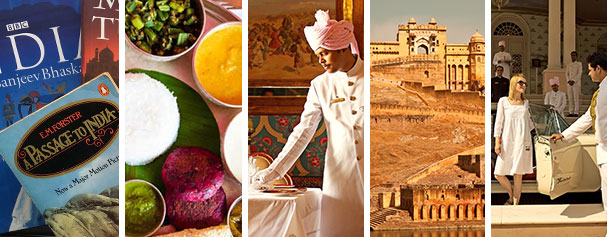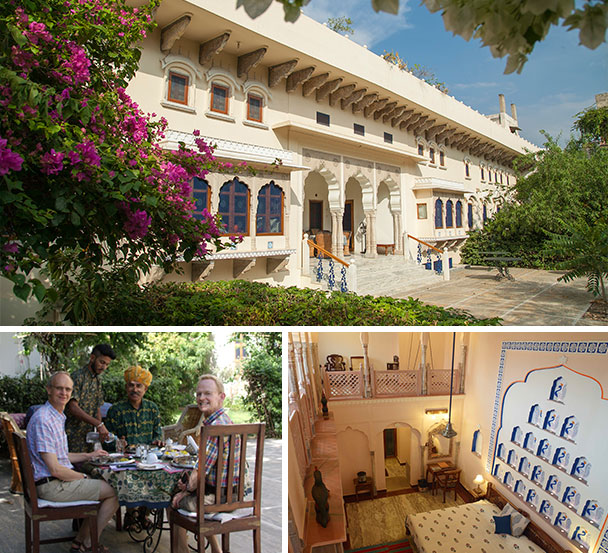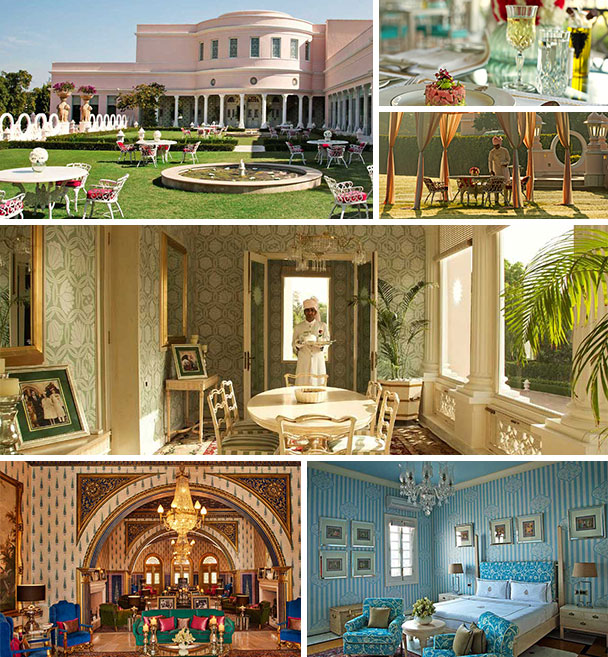March 2, 2017

Kabir, the revered fifteenth-century poet, has for many in Northern India become an anti-caste icon.
His verse, set to music throughout the diaspora, is used to challenge outmoded institutions and rigid orthodoxy. He also seems to be the patron saint of the Jaipur literary festival where many thousands of people come to take part in freethinking debate and to listen to authors from all over the world.
The festival, for which there is no entrance fee, is a breath of fresh air for increasingly polarised societies, enabling them to express and embrace diverse views. The attendance list is impressive: in 2011, two Nobel Laureates and seven Booker Prize winners attended, Oprah Winfrey was there in 2012, and in 2013 the Dalai Lama and Sebastian Faulks spoke. You get the idea!
Sawai Jai Singh started to build Jaipur in 1727; a visionary ruler and designer, he created a city on lines which, in contrast to the defensive mediaeval layout of the former capital at Amber Fort, are strikingly modern. Jaipur was to emerge as a commercial and business-orientated city, Jai Singh encouraging bankers and the founders of arts and crafts guilds to settle here rather than the traditional warlords.
The bazaars today are a spangly treasure-trove, providing the perfect setting for the colourful sari swirls of the ladies of the Pink City. A highlight of the city for me is the fascinating Jantar Mantar, an open-air observatory where you can marvel at mammoth eighteenth-century celestial devices and sundials, all still in perfect working order. A private tour on a recent visit to the City Palace revealed my favourite room: a small hall of mirrors where slivers of glass are set on relief work, so the plants imitated seem to bulge and curve. Two candles are lit, the doors are closed and all of a sudden one can see tiny pinpricks of light refracted and duplicated everywhere.
The city warrants the minimum of a three-night stay, even if you do not go at festival time. Next year the dates are from 19th to 23rd January.

One small mansion or haveli is Dera Mandawa, an unpromising building on one’s approach but within a haven of peace with a large central courtyard containing a myriad of trees and shrubs.
The turbaned and tall owner Durga Singh graciously receives visitors in what is very much like a family drawing room, full of photographs of his distinguished forebears. Alas, he explains, he is a scion of an aristocratic family who like all of his Rajput caste had to find some way of making ends meet as their wealth was increasingly appropriated in the decades following Independence.
The haveli has a lovely feel to it and, mindful of how easily the young can become switched off by a plethora of visits to historical sites, Durga Singh offers classes in turban-making, kite-running and cookery. One of his rear courtyards houses his prize cows whose dung is ingeniously used to provide methane gas for cooking via a contraption with a floating cover just like a gasometer. Rainwater is collected and with an osmosis plant converted into drinking water for the rooms, reducing the use of plastic bottles.

For a time it was the official residence of the British Political Agent and from 1958 until 1970 the private residence of HH Maharaja Sawai Man Singh II – or Jai – when it hosted visits from distinguished guests such as the Queen, Jackie Kennedy and the Mountbattens.
It actually looks much more modern than its eighteenth-century origins would suggest: a massive columned portico over grand white steps leads to a central salon which is clad in rich dark wallpaper and furnished with groups of lavishly upholstered sofas and occasional tables bearing silver-framed photographs of the Mountbattens, the Kennedys and polo players. The exterior is painted in light pink and white – a combination of colours deliciously reflected in the white coats and trousers and pink flowing turbans of the army of waiters who are ready to bring tea, water or a towel at the merest glance.
All the rooms have specially created wallpapers and original, reupholstered furniture – and the dining rooms, pool and surrounding walls are all art deco, the circles and diamond shapes which pierce the walls giving a wonderful lightness and grace to the whole. With its clean lines, pastel shades and green open spaces, the Rajmahal is a masterful reinvention of a traditional palace and a welcome palette cleanser after all the sumptuousness and grandeur of Mogul architecture. Even if at times it is like living in an interior in Wallpaper magazine one is left with an impression of an outstandingly well run and distinctive hotel.
NB prices shown were current at the time of writing the newsletter and are not necessarily current now.
Please ask for an updated quote.
- The Khajuraho temple complex, a Unesco World Heritage Site
- A Sense of Place: Poignancy in KwaZulu Natal
- A Sense of Place: Northern Botswana
- A Trio of Treats in India
- And now for something completely off grid and different: AFRICA’S ULTIMATE RAINFOREST SAFARI
- A Trio of Treats off the beaten track – We get you to places that others don’t!
- A Trio of Treats On The Rift Valley
- A Sense of Place – Can the muppets save a species?
- Trio of treats (Rajasthan, Maldives and Garden Route)
- A Sense of Place – A favourite place: Tanzania and Ruaha
- A Sense of Place – A favourite place in Botswana: the Okavango with elephants galore
- A Sense of Place – Here be dragons and a dark past
- A Sense of Place – Justice Regained
- A Sense of Place – Summer rains make the roads impassable
- A Sense of Place – ‘Those two ladies put light in my future.’
- A Sense of Place – The bird who lost its nest
- A Sense of Place – Talking with the Maasai
- Newsflash: first American guests to Tanzania since March 2020
- A Sense of Place – AFRICA NEEDS YOU
- Escape to Italy?
- Covid: the road still to be travelled.
- A trio of treats. Series of 3 (Part 3): Tiger reserves.
- A trio of treats. Series of 3 (Part 2): Khajuraho.
- A trio of treats. Series of 3 (Part 1): Lucknow.
- A Sense of Place – Engaged people may save the planet
- A word on lions and a trio of treats
- A Sense of Place – India’s most holy city
- A wealth of wilderness walks in Namibia
- Travel snippets from Miles
- A trio of treats on the green island of Pemba in the Zanzibar archipelago
- A Sense of Place – THE INSIDE TRACK on Cape Town guiding
- A Sense of Place – Migrations of people and beasts: East Africa
- A Sense of Place – An era of revolution and global alliances
- A Sense of Place – A walk on the wild side
- A Sense of Place – The ghost ingredient is back
- A Sense of Place – Liuwa Plains and Kafue National Parks – Zambia
- A Sense of Place – Literati in the Pink City, the Capital of Rajasthan
- A Sense of Place – A Tamil town still connected to Europe, Art Deco architecture, and temple antiquity in Southern India.
- A Sense of Place – Dreamy aquamarine sea and stunning safari with the Makuleke people
- A Sense of Place – A trio of lovely ladies in Hyderabad
- A Sense of Place – Entamanu, the wishing tree and walking with the Hadza tribe.
- We get you to places that others don’t… St Helena, Gt Zimbabwe ruins and Papua new Guinea
- A Sense of Place – Walking in the hippie hills of the Himalayas
- A Sense of Place – The Okavango: the river that never finds the sea
- A Sense of Place – The Great Rift Valley, Laikipia, Samburu warriors and Maasai Olympics.
- A Sense of Place – Escape the world in the Namib Desert
- Africa is a massive continent: a collection of 55 countries
- A Sense of Place – Zambezi Watery Wilderness
- A Sense of Place – Burma: the road beyond Mandalay
- Lake Malawi – Would you rather pay for the advertising or the experience?
- From shoe-shine boy to tourist guide in Ethiopia
- A Sense of Place – Ladakh, the Himalayas
- Dhow sailing, Lions are back in Malawi, Self-drive in Namibia
- Sacred rivers and forts, India
- Piranhas, sting rays, caimans – and still people go into the River Negro!
- Kerala, Southern India – God’s own country
- South Africa: Crucible of the rainbow nation
- Madagascar: croissants and lemurs
- Argentina vs Africa on wildlife drama
- Uganda – Gorillas and Gardens
- Mozambique & Kenya: immigration official on holiday
- Mozambique: Gorongosa and reconciliation in the bush
- Zimbabwe is ready for Tourists again
- Serengeti ecosystem and unbeatable savannah
- Lamu: crab complaining
- Kenya: circumcision
- Zambia: Ellie rescue
- Africans: always smiling
- Tswalu
- French sketch
- Kenya: the best hosts
- First visit to Africa 1986
- Namibia, Namib Rand, Skeleton Coast and the ultimate flying safari
- A few gems off the beaten track: Fanjove Island, Tanzania; The Singular Hotel, Patagonia and Isla Palenque, Panama.
- Elephant relocation, quad bike expedition and new Sossusvlei reserve
- Templed out in Tamil Nadu and elephant refuge in Jaipur
- Kenyan sanctuary and family run camp in Zambia
- Australia: Arkaba, Tasmania and Lord Howe Island
- Australia: in the outback and off the beaten track
- India: heavenly Himalayan hideaways, Botswana: fun safari for children and Argentina: hidden homestay in a mountain desert
- Limpopo retreat, Serengeti spectacle and adventure on the Zambezi
- Value for money in Kenya and the trail less travelled in Peru
- Lions in danger, free nights and a new coastal gem
- G and T on demand, hidden beach, micro-light and sleeping on a dam
- Off the beaten track